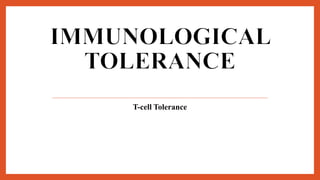
Immunological tolerance by Arad Boustan
- 2. CentralTolerance In the thymus, the epitopes recognized by these receptors consist of: • a small molecule, usually a peptide of 6–8 amino acids derived from body proteins; that is, "self" proteins nestled in • a histocompatibility molecule (encoded by the MHC) • class II for CD4+ T cells • class I for CD8+ T cells
- 3. CentralTolerance SomeT cells bind to epitopes tightly They are deleted by apoptosis Negative selection SurvivedT cells leave thymus and migrate throughout the immune system
- 4. CentralTolerance There are many proteins that are expressed only in differentiated cells that are restricted to a particular tissue e.g., the insulin-producing beta cells in the islets of Langerhans in the pancreas. How is central tolerance to these proteins achieved in the thymus?
- 5. AIRE
- 6. Individual organs of the body express tissue specific antigens retina ovaries In the thymus,T cells arise capable of recognizing tissue- specific antigens Under control of the AIRE protein, thymic modullary cells express tissue specific proteins deleting tissue-reactiveT cells
- 7. In the absence of the AIRE,T cells reactive to tissue- specific antigens mature and leave the thymus
- 10. PeripheralTolerance The T cells that leave the thymus are relatively — but not completely — safe. Some will have receptors (TCRs) that can respond to self antigens • that are present in such high concentration that they can bind to "weak" receptors; • that they may not have encountered in the thymus.
- 11. PeripheralTolerance 1. Negative Selection in the Peripheral Immune System 2. Lack of Co-stimulation 3. Failure to Encounter Self Antigens 4. Receipt of Death Signals 5. Control by RegulatoryT Cells
- 12. PeripheralTolerance • Negative Selection in the Peripheral Immune System AIRE is also active in some antigen-presenting cells in the organs of the peripheral immune system, e.g., lymph nodes and spleen. So any potentially autoreactive T cells that failed to be eliminated in the thymus can be selected against in these tissues
- 13. PeripheralTolerance • Lack of Co-stimulation In order to become activated, the T cell must not only bind to the epitope (MHC- peptide) with its TCR but also receive a second signal from the APC. The receipt of this second signal is called co-stimulation. Among the most important of these co- stimulators are molecules on the APC designated B7 and their ligand on the T cell designated CD28. The binding of CD28 to B7 provides the second signal needed to activate the T cell AlthoughT cells encounter self antigens in body tissues, they will not respond unless they receive a second signal
- 16. PeripheralTolerance • Lack of Co-stimulation Most of the time, the cells presenting the body's own antigens either • fail to provide signal two • transmit an as-yet-unidentified second signal that turns the T cell into a Regulatory T cell (Treg) that suppresses immune responses. In either case, self- tolerance results
- 17. PeripheralTolerance • Failure to Encounter Self Antigens Some tissues are hidden behind anatomical barriers that keep T cells from reaching them. Examples of such privileged sites • interior of the eye • testes • the brain
- 18. PeripheralTolerance Failure to Encounter Self Antigens Immunosuppressive factors • Nuropeptides • TGFβ • indoleamine 2 3-dioxygenase expression of FasL and PDL-1
- 20. Figure14.8 Immunobiology ,7ed, Garland science
- 21. PeripheralTolerance • Receipt of Death Signals Some cells of the body express the Fas ligand, FasL. Activated T cells always express Fas. When they encounter these cells, binding of Fas to FasL triggers their death by apoptosis Lack of Fas Autoimmune Lymphoproliferative Syndrome(ALPS)
- 23. PeripheralTolerance • Control by Regulatory T Cells A minor population of CD4+ T cells, called regulatory T cells (Treg), suppresses the activity of other T cells. They may be important players in protecting the body from attack by its other T cells. IPEX
- 24. Origin of regulatoryT cells tTreg nTreg
- 26. Peripheral tolerance of CD8+T • More research should be held • Without co-stimulator molecules andT helper they can convert into anergic cells • Exhaustion